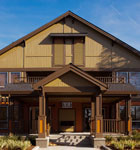It’s not easy to design a senior living facility. Regulatory agencies, economics, and the mission of resident care, comfort, and vitality make it a complicated business. Layering sustainability on top might seem an added burden. But the nation’s largest operator of such facilities, Brookdale Senior Living—owner of 645 retirement communities with 60,000 residents—is getting greener, one development at a time. Though no facility has yet applied for a LEED certification, significant sustainability measures being implemented incrementally actually help achieve a community’s other dictates.
“We’ve acquired many existing communities in recent years,” says architect Jay Keopf, Brookdale’s senior director of development. “Many of the buildings are 15 to 25 years old and ready for significant renovation. Rather than turn to new construction, we re-position the communities, retroactively making them more purpose-built. We recycle the whole building.” By ensuring buildings remain acceptable to the market—which includes independent living, assisted living, skilled nursing, and “memory care” communities—the waste involved with new development is avoided.
The matter of indoor air quality and temperature is highly important in senior living facilities because older, sedentary individuals are exceptionally sensitive to cool drafts. So perhaps the most significant recent change in HVAC systems for senior residences is the shift from PTAC (through the wall-style) heating and cooling units, which are largely inefficient, to centralized HVAC systems using enthalpy economizers. Independent and assisted-living residents still maintain control of their thermostat, but the building’s net use of energy is far less and indoor air quality much improved.
Other mechanical-system improvements in these building projects include demand-control ventilation and lighting in bathrooms and multipurpose areas, condensing-type water heaters that use ambient air temperature to warm incoming water, and high-efficiency condensing furnaces. All buildings have been retrofitted with CFL and LED lights to replace incandescent lamps where possible, and as carpeting is replaced, the company works with companies such as Shaw, which offers Cradle to Cradle-certified products.
Windows are a huge part of sustainable senior living, both literally and figuratively. Most states have specific requirements about fenestration: first, that every resident be offered opportunities for natural light, and second, that those windows pose no threat to their safety. As Brookdale facilities are updated, windows with specialized glazing to minimize heat transfer are used to improve energy efficiency and resident comfort.

“Evidence-based design in healthcare looks at the resident experience when trying to improve a facility. It’s about artwork, music, beautiful natural light, and bringing back happy memories.” Phillip Tomlinson, ESa
However, it’s access to the outdoors—through views and through physically leaving the building—that matters most. Phillip Tomlinson is a project manager with ESa, a Nashville, Tennessee, architecture firm that designs many Brookdale properties. He explains the broader need to provide residents with opportunities to see and be outdoors. “We operate off the principles of evidence-based design, which is part of the patient-centered movement,” he says, citing the work of Planetree, an organization promoting ways that design can humanize the healthcare experience as a means to better health outcomes.
“Evidence-based design in healthcare looks at the resident experience when trying to improve a facility. It’s about artwork, music, beautiful natural light, and bringing back happy memories.” In practical terms, that includes exterior courtyards, with minimal stairs and low-sloping rises on paver bricks that won’t trip shuffling feet. It’s “little porches, garden benches, sunrooms, and dining rooms that continue outside,” Tomlinson says. Most state regulations already require a certain amount of outdoor access, and the USGBC includes “connection to the natural world / places of respite” in the LEED standards for healthcare facilities. Even the medical establishment backs up the idea. In recent years, the value of vitamin D, the “sunshine vitamin,” has become regarded as an important factor in senior health.
In Brookdale’s case, sometimes thinking green brings benefits for everyone, even neighbors. For a recent renovation, general contractor HarenLaughlin graded hilly terrain for The Sweet Life at Grand Court, a Brookdale community in Overland Park, Kansas. Numerous truckloads of soil had to be removed from the property. The company decided to donate the dirt to a high school adjacent to the development, in order to build a well-drained football field. It was a sweet solution for The Sweet Life facility and another example of how green thinking solves multiple problems.


